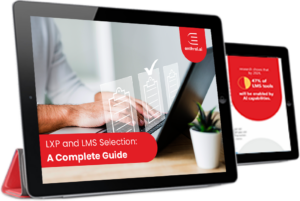Navigating L&D Budgets: Key Insights & Tips to Drive Performance

L&D is key for any business to thrive. If your team isn’t learning, they aren’t growing. Moreover, as the go-to person for all things learning and development, it is up to you to make sure your company’s growth doesn’t hit a roadblock. This means ensuring they invest well in training and development.
But figuring out how to budget for this isn’t as simple as just throwing money in every year. There are tons of ways to spend those funds effectively and some ways are definitely better than others!
In this blog post, I talk about what makes a good L&D budget and how to build one.
Let’s start from the start.
Why L&D Budgets are Important
An L&D budget sets the roadmap for the future. It is about prioritizing spending on what truly matters to employee development.
The 2023 Fosway Report points out that the percentage of L&D teams expecting a decrease in their overall budget has gone up from 8% to 21%. Echoing similar findings, the 2023 Learning at Work report highlights limited budget as one of the top three barriers to achieving organizational and people goals. Both these reports indicate the significant challenges organizations face in 2024, balancing tighter budgets with the need for more robust investments.
Needless to say, developing a strategic approach to budget allocation for L&D is more vital than ever now.
L&D Budget Allocation Strategies
When it comes to strategizing for your L&D budget, there are several factors to consider. We begin with five areas:
1. Evaluate Your Organization’s Objectives
Checking out your organization’s goals helps steer learning efforts in the right direction. This means every training session counts towards hitting those bigger goals, making the most of resources, and turning learning into a major asset.
Firstly, dive into a Skills Gap Analysis. Take a good look at your workforce to understand who’s bringing what to the table. You can use tools and technology to map out core skills needed for different roles, pinpointing strengths and areas that need development. This lays the groundwork for tailored training programs to fill those gaps.
Secondly, focus on collaborative planning. Departments operating in silos can lead to disjointed learning efforts. Sit down with key players, chalk out precise objectives and keep tabs on progress. By building collaboration between teams, you can refine plans and collectively work towards organizational goals.
2. Look at Past Performance for Budget Allocation
Evaluating past learning initiatives and budget allocation is necessary for smart L&D budget planning. It gives you insights into what’s worked well before and where there’s room for improvement.
Begin by measuring the effectiveness of past learning programs in meeting their goals. This helps you make informed decisions and tweak future budget allocations for maximum impact.
Then take a closer look at how your past budget was spent on learning initiatives. Identify areas where money was well-spent and where it might have been misallocated. This analysis helps you fine-tune your budget for future L&D efforts, ensuring you get the most bang for your buck.
3. Anticipate Future Learning Trends & Technologies
Predicting future learning trends helps you adjust your learning strategies ahead of time, making sure your employees have the skills they need to adapt and thrive.
One way to do this is by creating a technology adoption roadmap. This helps you seamlessly integrate learning technologies into your existing setup. By spotting emerging trends, understanding their impact and planning out how to roll them out, you can make sure your L&D efforts stay ahead of the curve.
4. Set a Clear Budget Based on Learning Priorities
Oftentimes, budgets are thrown around without really getting what the team needs to learn, which means money down the drain. To make sure learning programs hit the mark, L&D teams should set a clear budget based on what the team really needs to learn. This means putting resources where they matter most and tackling those urgent learning needs head-on.
First up, figure out what those top learning needs are. Use all the tools at your disposal: surveys, feedback, you name it, to find out where the team’s skill gaps are. Once you have that nailed down, it is time to allocate resources. Whether it is investing in training programs, new tech or getting experts onboard, make sure it is all about smart resource allocation.
Also Read: How to Choose the Right Training KPIs for L&D Measurement
5. Establish a Flexible Budget Plan
Having a flexible budget plan is a must because it allows you to roll with the punches, whether it is unexpected shifts in the market or new learning needs.
So, how do you make your budget plan as agile as possible? Start by setting up a budget that allows for continuous checks and tweaks based on what’s happening in the organization. By getting everyone involved, you can make sure your learning budget stays in sync with the times.
And don’t forget about planning for the unexpected. Allocate a chunk of your budget to an emergency fund. This way, you can handle any surprises that come your way without derailing your learning plans. It’s all about staying flexible!
Allocating Your L&D Budget the Right Way
Figuring out how to allocate your L&D budget can actually make or break your initiatives. Here are a few approaches for this:
#Approach 1 L&D Budget Per Employee: This means setting aside a certain amount for each person, making sure everyone gets a fair shot at learning. But if you have a big team, this might not be the most cost-effective route.
#Approach 2 L&D Budget Per Team/Department: This lets you tailor your L&D programs to each team’s specific needs. It is great for customization, but watch out for any discrepancies between departments.
#Approach 3 Allocation based on Performance: This is all about rewarding your top performers with extra training perks, like leadership development. It is a way to invest in your standouts and help them shine even brighter.
#Approach 3 Allocation based on Projects: If you have a specific project or initiative in mind, you could opt for this approach. Whether it is launching a new product or rolling out a big change, you can earmark funds for the training and development needed to make it happen.
#Approach 4 Needs-based Allocation: This means putting your budget where the need is greatest, whether it is enhancing sales training or honing in on something else entirely. It is all about targeting your training investments where they will have the most impact.
Determining the Best L&D Budget Allocation Method
The most optimal way lies in striking a balance between equal and targeted investment aligned with your business objectives.
Consider adopting a hybrid allocation approach, blending various methods to create a comprehensive L&D program tailored to your organization’s needs. For instance, allocate a fixed amount per employee for mandatory training while earmarking additional funds based on performance, project requirements, or specific team needs.
When allocating your L&D budget, carefully evaluate the advantages and disadvantages of each approach to determine the most suitable option for your organization.
Exploring LMS and LXP Budget Allocation
When planning your L&D budget, earmarking funds for a learning platform, be it LMS or LXP is a game-changer. So, don’t skip that!
Here’s why:
- An LMS/LXP can streamline your training programs, saving you loads of admin time.
- You can target specific areas and track progress effortlessly.
- It is a one-stop shop for mandatory training like compliance training, sales training, employee or even partner training.
- It not only saves you money in the long run but also beats traditional training methods hands down. With an LMS/LXP, you are always up-to-date. You can change training content on the fly, ensuring your team gets the latest info when they need it most.

LXP and LMS Selection: A Complete Guide
- Decoding & comparing LXP and LMS
- Practical applications for LXP and LMS
- Critical considerations in selecting the best system
Budget Monitoring Essentials
Keeping an eye on your budget is crucial to ensure it aligns with your business needs and goals. Here are some tips to do it effectively:
- Regularly review each budget item against its costs and benefits to spot any changes in timeframes or resource needs.
- Create a checklist to review all projects, comparing estimated costs with actual ones to catch any discrepancies.
- Keep stakeholders informed by reporting budget status regularly, creating transparency and trust.
- Quarterly, compare actual costs with budgeted ones to stay on track.
- Revise the budget frequently to adapt to changes in the business landscape.
- Share continuous L&D performance, including estimated vs. budgeted expenses and ROI, with HR partners for insight and collaboration.
Wrap-Up
Finalizing the budget and getting it signed off is just the beginning of your role. Remember, your L&D budget is dynamic and should evolve with your business. If significant changes occur, like hiring or department restructuring, revise the budget to ensure everyone has the learning resources they need during the transition. The key is to continuously evaluate its impact and make adjustments as needed!











